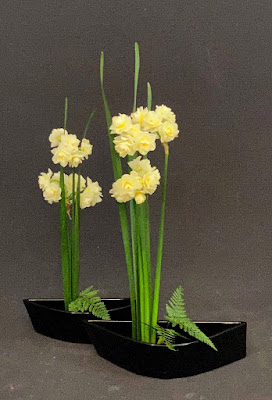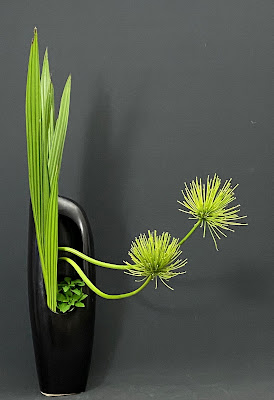 |
| Camellia extravaganza |
Hello all,
My arrangement, above, will seem quite extravagant to those of you with small or no gardens but my tree is a big one and in full bloom. Those said blooms will end up on the ground very soon, so I might as well use them. Under other circumstances I would be sharing some of them with my students but, alas, we are in lock down for the 6th time and are having no classes.
I'm quite grateful to have this block, for which I need photos of ikebana each week. I'm surrounded by wonderful materials and have the insatiable need to create ikebana. With the lockdown, no one but Sam can see my work in the house, so this blog is my window to the world, small as it is.
 |
| Variegated Ivy and clivia berries |
Last week I heard chain saws in the neighbourhood and, upon investigation, I discovered that some trees had been pruned and branches left on the pavement. Among them were pine branches (pinus radiata). Of course, I collected some for my own use. Again, under other circumstances, I would have taken a lot more so as to run a workshop with my class. But, instead, I did a small workshop by my self.
The area we live in has mature, pine trees in great abundance because they were planted as wind breaks by the orchadists, mainly German, who first settled here. August is the flowering month for pine trees. They produce huge amounts of yellow pollen when in flower, covering everything - plants, trees, paths, window sills, cars etc. When I picked up my chosen branches, I shook them vigorously many times before I could safely put them in my car. Despite that, pollen continued to drop onto the table where I placed the arrangements.
 |
| The pine branch as it was when I picked it |
I pruned the branch quite heavily and could have left it without a container because it has a thick enough stem to survive without water for some time. However, I wanted to use the arum lilies, which do require water. I compromised by using the smallest container possible.
I used another large branch in this next arrangement, again with large arum lilies. It's what's available but, also, well suited to use with pine. I removed about one third of the pine needles but the branch still looks very dense. That's mainly because the photograph does not show depth.
 |
| This arrangement measures 1.1 metres across |
I tried something new with one of the off cuts of the pine. I removed all of the needles, leaving only the flowers and made a modern arrangement, using one leucodendron flower. The pine stems curve forward, 'hugging' the metal container.
My colleague, Christoper James, who runs the blog
Roadside Ikebana, had featured this tiny flowered, Native Clematis, C. microphilla, in his blog. I recently noticed that it grows prolifically along the side of the road in our area and, having dismissed it in the past, I took the trouble to take a closer look at it. It's really quite charming, after you manage to disentangle it from the host over which it grows and itself. Its cascading form reminded me of a bridal veil and I used it accordingly. The only downside to this material is that it only lasted a couple of days.
 |
| Closeup of the tiny flowers |
It was about a month ago that Christine had given me branches of the Illawarra Flame Tree, which I used in a couple of arrangements. When I emptied the bucket today, I found a stem with one leaf still holding on. I was amazed at how long it lasted and how beautiful it was as it's changing colour.
Bye for now,
Emily


















































